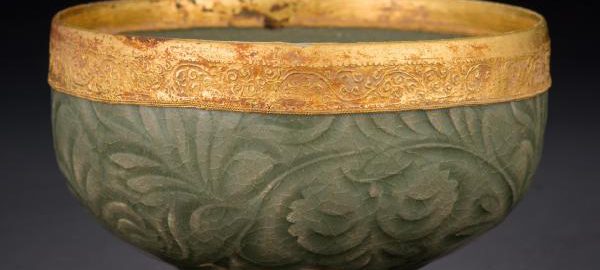
Bowl with Peonies
China, YaoZhou kilns
11th Century
Porcelain with Vietnamese gold rim
Celadon wares were highly regarded by the Chinese Imperial court as they resemble the colors of jade, traditionally the most highly valued material in China. An addition of Vietnamese gold rim showed cross-cultural exchange between both countries at that time.
[Linking back to our group gallery guide on colours and culture]
[History]
11th century China was under the Song Dynasty and it was divided into two distinct periods, Northern and Southern.
“Green in the south, white in the North” was a phrase for ceramics in China as Longquan, Zhejiang province (Southern China) were known for their greenwares while Hebei province (Northern China) were known for their whitewares. Celadons are produced by firing a glaze containing a little iron oxide at a high temperature in a reducing kiln.
What is interesting about this artifact that is a YaoZhou ware, a type of celadon porcelain produced in Northern Song dynasty.
[Production]
Although it is studied that 75 percent of pottery kilns built and porcelain produced in 130 provinces during the Song period, YaoZhou wares were only made in modest modest quantities. This could be because pottery in Northern Song were considered a focus of connoisseurship after an early-eleventh century emperor ordered his valued porcelains to have their unglazed rims adorned with gold and silver. Thus making Song porcelains highly prized, just below bronze and jade. Another possible reason could be that at the end of the Northern Song in 1125, the remainder of the Imperial court fled south, hence a lost of technique overtime in YaoZhou wares, and their style adopted and replaced by the Longquan kilns promoted by the court.
[THE YAOZHOU KILNS: A RE-EVALUATION <- Interesting Study on the lost of YaoZhou wares]
Because of the limited quantity of Yaozhou wares produced, they were not exported in great quantities, as only a handful of fragments can be found in indonesia and vietnam.
[Decorations]
Before the Song dynasty, the Tangs decorated their pottery with Buddhist motifs (eg. lotuses, gems, Bodhisattva) as a kind of ‘fashion statement’ for privileged ranks. However, the Songs reduced the Tangs styles with motifs of vines and leaves. Tang ceramics focuses more on exotic motifs, vigorous naturalism and painted adornment, while Song porcelains are characterized by reserved decoration, balanced proportions and
monochromatic shades.
Yaozhou ware are most commonly found in the shape of a bowl. Earlier wares were normally left un-decorated until carving was introduced, which introduced the light and dark shades as seen in the chosen artifact.
A possible reason for peonies being decorated on this bowl could be link to the ‘Song dynasty art of flower arranging’. Porcelains display flower types that matches its vessel, exhibiting flowers that blossoms in the summer and autumn.
[China and Vietnam]
In the early 10th century the Tang dynasty in China collapsed. The Vietnamese seized the initiative and launched a long overdue revolt against Chinese rule in Vietnam, thus forming the Ly dynasty. Annan (Annam, a southern province in China) was spreading the gifts of high civilization, such as trades and pottery making, to the Champa region of central Vietnam. A possible reason how this artifact ended up in Vietnam, also show cross-cultural influence.
I wasn’t able to find any information about Vietnamese pottery involving gold rims. There are two suggestions for the gold rims added onto the porcelains:
1) It can be considered a form of repair, to cover up a possible unglazed rim.
2) Just like the story of the emperor, adding gold rim onto the bowl was a form of decorative purpose.
But we can agree that gold was considered a valuable material and to add gold and celadon ware together made this artifact highly valuable.

Normal
0
false
false
false
EN-US
JA
X-NONE
/* Style Definitions */
table.MsoNormalTable
{mso-style-name:”Table Normal”;
mso-tstyle-rowband-size:0;
mso-tstyle-colband-size:0;
mso-style-noshow:yes;
mso-style-priority:99;
mso-style-parent:””;
mso-padding-alt:0cm 5.4pt 0cm 5.4pt;
mso-para-margin:0cm;
mso-para-margin-bottom:.0001pt;
mso-pagination:widow-orphan;
font-size:12.0pt;
font-family:Cambria;
mso-ascii-font-family:Cambria;
mso-ascii-theme-font:minor-latin;
mso-hansi-font-family:Cambria;
mso-hansi-theme-font:minor-latin;
mso-fareast-language:EN-US;}
This is one of the most beautiful objects that the museum owns!
You have provided some nice contextual analysis with attention to production, material, color, and motifs. Yes, you are indeed correct that adding the gold makes this bowl valuable and shows that it was valued by its owner—sort of like how European collectors enhanced their curiosities from around the world for display in their cabinets of curiosities.
Some questions:
*If the Song Emperor was commissioning celadon wares with gold and silver rims, how do we know that the gold rim on this bowl was added by Vietnamese potters?
*Why was jade so highly valued by the Chinese?
*What is a reducing kiln?
*Who was collecting these rare greenware in Vietnam and Indonesia? Why?
*Why did Song potters choose a more subdued group of motifs?
*How is the light a dark shades achieved?
*What a fascinating idea that there is a link between flower arrangement and the motifs on the bowl! But can such a tiny bowl be used for flower arrangement? Are there paintings from the Song dynasty that show flower arrangements?
*What were the possible functions of this bowl or this type of war in Vietnam and Indonesia?
*Also, what did peonies mean in the Song dynasty?
*The rim seems to have designs too—was this added when the gold was added? Or, is it see through? In other words, the original design on the rim is coming through the gold?
*Where is your bibliography?